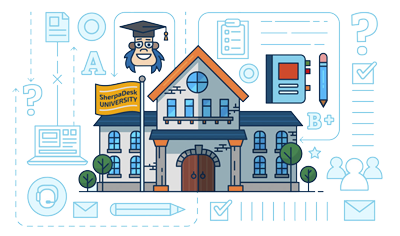by Jessy Smulski
What tech trends have the potential to disrupt your industry this year? We have some compelling predictions that may impact your small business strategy.
Each year, Gartner releases a list of what they predict will be the most disruptive technology trends of the year (and beyond). As a small business owner, keeping a pulse on tech trends is not only a great way to establish leverage in the market; it’s also essential to your long-term survival. Take a deep breath and prepare to have your mind blown.
Gartner's Top 10 Strategic Technology Trends for 2019 report is further proof that technology isn’t slowing down any time soon.
Predictions Related to Tech Intelligence
1. AI and the Rise of Autonomy
Artificial intelligence (AI) enables technologically advanced devices to complete human tasks. In recent years, we’ve gotten used to the idea of AI-enabled workplace management software, Helpdesk software, chatbots, and other types of robotics, but according to Gartner, this is just the beginning.
By 2023, “virtually every application, service and IoT object will incorporate some form of AI to automate or augment processes or human actions.”

2. Augmented Analytics
Data is utterly useless without the means to organize, analyze, and draw insights. Given that we generate about 2.5 quintillion bytes of data every day, it was only a matter of time before the meticulous labors of data science collided with automation to make sense of this tsunami of information. Augmented analytics uses Machine Learning and Natural Language Process to automate the analysis of data. Using this technology, data scientists can develop algorithms that mine for specific information to draw out the most valuable conclusions more efficiently.
According to Gartner, 40% of data science tasks will be automated by 2020.
3. Development Driven by AI
Application developers are among the most evolutionary professionals of our time. Already, they’ve proven their adaptability through the widespread adoption of practices like DevOps. In 2019, they will continue to trail-blaze using AI-powered tools to drive their development processes. This also means that developers will build more AI into applications without the need for a professional data scientist.
Predictions Related to Digital Trends
4. Digital Twins
A digital twin is a real-life object, process, or system that is recreated in digital space. This technology may sound like old news, but Gartner suggests that in the very near future, we will have the capabilities to create twins of massive infrastructure systems, such as power plants or cities. Advanced digital twins can be developed to focus on specific business outcomes, link to real-world applications to heighten our monitoring and control abilities, and enable us to enact test scenarios to better understand, control, and safeguard mission-critical systems.
5. Empowered Edge
The Internet of Things gave rise to advancements in edge computing, which takes place partially or entirely on smart devices or edge devices instead of a centralized cloud environment. These advancements will lower WAN costs, improve latency, and connect people with hundreds of devices.
6. Immersive Experience
Over the next several years, we’re about to see virtual reality (VR), mixed reality (MR), and augmented reality (AR) combine to create a new level of immersive technology. Immersive technology will understand our physical environments better than ever and will have the sensory capabilities to detect emotions based on facial expressions and adopt human-like conversational and interactive skills.
“By 2022, 70% of enterprises will be experimenting with immersive technologies for consumer and enterprise use, and 25% will have deployed to production.”
Predictions Related to Mesh Network Technologies
7. Blockchain
The cryptocurrency market is only a sliver of the promise that blockchain technology holds. In basic terms, blockchain is a highly secure and accurate repository of transactional data that is organized in chronological order and impervious to tampering. As industries grow more aware of the capabilities of blockchain, we will begin to see its adoption as a security measure for health records, personal identity and lifetime benchmarking, digital voting, the Internet of Things, and much more.
Gartner anticipates that by 2030, blockchain will create $3.1 trillion in business value.
8. Smart Spaces
Physical and digital environments are about to bring humans and technology-enabled systems closer together than ever before via smart spaces. Thanks to the above technologies, we are nearing a reality in which we live and work side-by-side with highly intelligent objects and systems that are remarkably connected and interactive. For example, a smart city comprised of an AI-powered, IoT-rich infrastructure that learns from inhabitants, is responsive to activities and communicates information with the public to improve the efficiency, ease, and quality of life.

9. Digital Ethics and Privacy
Between Facebook and Equifax, recent years have served as a cautionary tale for consumers and the value of their personal information. Consumers are also learning that collectively, they have immense power over enterprises which fail to protect and serve the public. In lieu of these events, Gartner believes that the topic of compliance will move away from boxes to check on a list and toward more in-depth conversations involving ethics. This will hopefully force companies to work harder to earn trust by instilling ethical practices at the foundation of their business.
10. Quantum Computing
As traditional computing systems grow larger, they also become slower and less powerful. Quantum computing is infinitely powerful regardless of size. Gartner provided a comparison to explain the difference between traditional and quantum computing. If these two technologies were at a library:
“A classic computer would read every book in the library in linear fashion, a quantum computer would read all the books simultaneously.”
Once we harness the power of quantum computing, we will have the means to solve life’s greatest mysteries, especially related to medical science, climate change, and biophysics.
As a small business owner, you might see the adoption of these technologies as an insurmountable feat, but it’s not. The best way to prepare for disruptive technology trends is to start small. For example, many tech startups understand the importance of investing in an integrated helpdesk software platform, such as SherpaDesk, to bring automation to their business processes.









comments